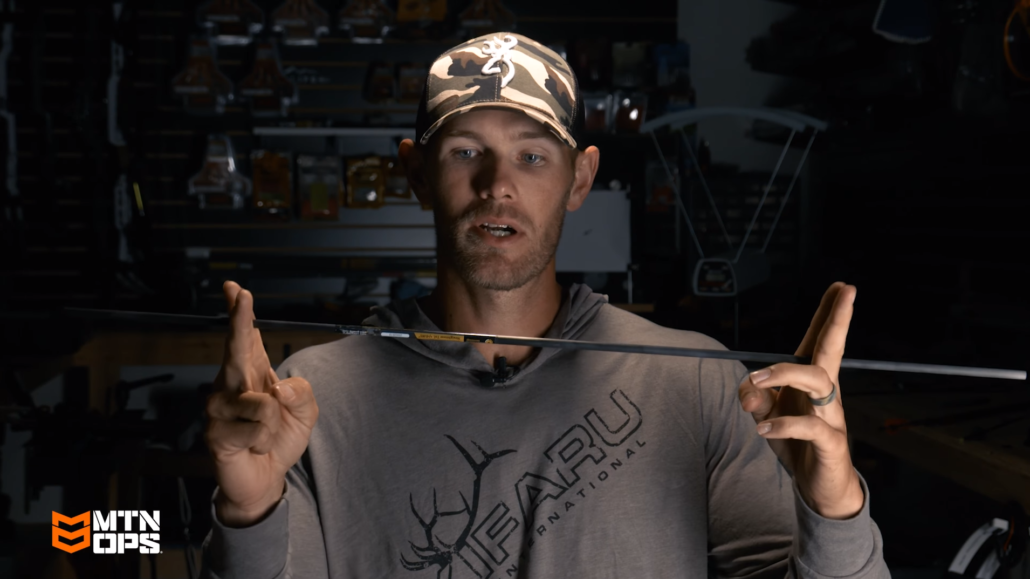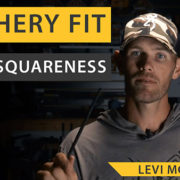“Archery Fit” Archery Tips | The Importance of a Square Nock End
The Importance of a Square Nock End
While today’s arrow shafts are extremely consistent compared to those manufactured just a few short years ago they are still a manufactured product and like any product subject to manufacturing tolerances. One of the advantages of fletching your own arrows is the fact that you have more control over the quality of the finished product and that starts with the simple step of making sure that both ends of the arrow are square and true to the center.
How Arrows Are Made
Aluminum arrows are normally produced though what is known as a “drawing process”. During this process, aluminum tubes are heated and “drawn” or pulled to obtain the desired outside and inside diameter which results in an arrow suited for a specific draw length and bow weight.
Carbon arrows, on the other hand, are commonly made by “wrapping” a carbon cloth to form the arrow. In either case, each method is designed to produce a product that is as uniform as possible throughout its length. However, simply due to the manufacturing process, the arrow is most consistent throughout the middle of its length than either end. That means that when cutting a 28 inch arrow out of a 32 inch bare shaft it makes the most sense to take it out of the middle and cut two inches off of each end of the arrow as opposed to four inches off of one end only. This cuts the finished arrow out of the most uniform and therefore most consistent portion of the bare shaft.
Cutting & Squaring Your Own Arrows
For those of you that have your own cut-off tools, this is a simple matter. However, if you have your shafts cut at a pro shop you will have to make your desires clear to the shop technician. It is common practice for most pro shops to simply trim the one end, if they do so at all, and take the excess shaft from the other end in one cut. There may be a slight charge for the extra cut but it is well worth the cost.
However, when the arrow is cut to length the job is not done, it is just starting. The next and most important step is the squaring of the arrow ends. A high quality cut-off saw will do a good job when cutting the arrow but the blades on a cut-off saw are thin and flexible and depending upon the amount of wear on the blade the cut can be a little “wavy”. Also depending upon the experience of the operator it is possible for the cut to be at a slight angle, not visible to the eye, if the shaft is not held tightly against the cut-off saw guides. Regardless of the reason it is important to square both ends of the shaft to ensure the quality of the finished product after the shaft has been cut to length.
All manufactured items are built to within a tolerance range of plus or minus. When you put together several items those tolerances add up so to maintain accuracy it is important to eliminate or minimize any potential tolerance build-up whenever possible. When inserting a target point or hunting insert into a shaft there are several tolerances to consider, first is the difference between the inside diameter of the arrow and the outside diameter of the insert plus the squareness of the insert shoulder and the squareness of the shaft end. For best possible overall alignment the better the shoulder of the insert and the end of the shaft fit together the closer the insert will be centered with the inside of the arrow and any point, field tip or broadhead will, therefore, be more closely in line with the center of the arrow. This difference may not be as noticeable with a field tip or target point but when mounting a broadhead which again has its own set of manufacturing tolerances the difference can be quite dramatic.
All of the same truths can also be applied to the nock end of the arrow. If the nock end is out of square it will not allow the nock to properly seat in the arrow when inserted. This condition, in turn, can force the nock to make contact to the side of the actual center of the arrow shaft. This difference may not be noticeable to the naked eye but it is definitely noticeable to the dynamic forces to which the bow and arrow are subjected when the string is released.
The instant the bow string is released the power stored in the bow limbs is transferred to the arrow through its contact with the string. That power transfer is transmitted through the nock and into the arrow shaft itself causing the forward motion of the shaft. It is important that this power transfer is done as smoothly as possible and also as centered as possible. The ideal and most efficient situation is to have the force concentrated on the center of the arrow shaft. If the force is applied off center it creates unequal pressure on the arrow during the shot and with each arrow being different if the ends are not squared this condition gives more variation shot to shot resulting in inconsistencies.
For an example suppose your truck was sitting on a piece of slick ice and was out of gas and you had three buddies who were going to help push you down the road. The ideal situation would be to have one at each corner of the truck and one pushing in the middle which would equally apply their force across the back of the truck. This would equally apply the force to the truck which would also be centered moving forward. Let’s suppose on the other hand that all three pushed from one corner of the truck. Their total applied force when applied off center would have a tendency to move the truck at an angle to the side. Their applied force would not be properly directed resulting in a waste of effort and lack of control or induced error. This same logic applies to the square end of an arrow. Making sure the nock end is square enables the nock to fit properly with the shaft and ensures the power transfer from the string is as close as straight down the middle as possible.

PHOTO: Squaring the ends of an arrow is the first step when it comes to ensuring perfect nock alignment to ensure proper transfer of power from the string to the arrow. Squaring the end of the arrow also provides better point alignment and broadhead flight. A squaring tool allows the squaring of both ends of bare shafts before fletching as well as the nock end of arrows already fletched.
Simply sanding the end of the shaft may make it smooth but it does not guarantee that it’s square. Squaring the shaft ends is simple, takes only seconds to do and is well worth the time and effort.). A Squaring tool is designed to square arrow ends to ensure the proper fit for activating Nockturnal Lighted Nocks it is also ideal for squaring both ends of the arrow for the reasons described above. A squaring tool is a simple v-rest tool with a sand paper disk at one end against which the arrow end rest. A few simple turns of the arrow against the disk and any irregularities or high spots are quickly removed leaving a smooth flat square surface perpendicular to the center of the arrow. If you cut-off your own arrows having one of these tools makes the job complete. Ask your pro shop if they have one available for squaring your shafts if you have shafts cut there. If they do not provide that service consider making the investment yourself if you intend to build your own arrows.
Conclusion
Some shooters might ask, “Is all this really necessary, after all, does a little bit really matter?”. If you ever lost a tournament because one of your arrows is “just out a little bit” you would not ask that question. Every serious archer, be they a tournament shooter or a bow hunter should strive to be the best they can be. Success in both fields is often determined by fractions of an inch. With equipment and shooters today being highly focused on every aspect of their game there is little room at the top and often the second place is quite crowded. To be your best and stand above the crowd it is necessary to ensure your equipment is performing at its best and the place to start is with the squaring of your arrow ends.



